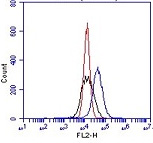CD51 (ITGAV) (+Beta-3 Integrin) Mouse Monoclonal Antibody [Clone ID: BV3]
CAT#: AM26367FC-N
CD51 (ITGAV) (+Beta-3 Integrin) mouse monoclonal antibody, clone BV3, FITC
Conjugation: Unconjugated
Other products for "ITGAV"
Specifications
| Product Data | |
| Clone Name | BV3 |
| Applications | ELISA, FC, IF, IHC, IP |
| Recommended Dilution | Flow cytometry (2): Stains the extracellular domain of integrin αvβ3 . The cells were fixed in 4% paraformaldehyde before before analysis . Negative control the primary antibody was omitted (Ref.2). The typical starting working dilution is 1:50. Immunoassays. Immunoflourescence (3). Immunoprecipitation. Immunohistochemistry on paraffin sections (1): Tissue sections fixed in Histochoice and blocked with 5% BSA (Ref.1). The typical starting working dilution is 1:50. Positive control: HUVEC cells. Does not work in Western blot. |
| Reactivities | Human |
| Host | Mouse |
| Isotype | IgG1 |
| Clonality | Monoclonal |
| Specificity | The monoclonal antibody BV3 recognizes human alpha-V/beta-3 integrin present on human cells. |
| Formulation | PBS Label: FITC State: Liquid Ig fraction Stabilizer: 1% bovine serum albumin Preservative: 0.02% sodium azide |
| Concentration | lot specific |
| Purification | Protein G |
| Conjugation | FITC |
| Storage | Store at 2 - 8 °C. |
| Stability | Shelf life: one year from despatch. |
| Gene Name | integrin subunit alpha V |
| Database Link | |
| Background | Integrins are a superfamily of αβ heterodimeric cell-surface adhesion receptors found in many species. They are expressed on a variety of cells and mediate numerous physiological processes, including inflammation, migration, adhesion and proliferation. The β3 family consist of 2 members: αIIbβ3 and αvβ3, which mediate cell-cell and cell-ECM interactions and are important for cellular migration, regulation of gene expression, cell survival, adhesion and differentiation. All processes which are involved in tissue development, angiogenesis and thrombosis. Each subunit consist of an extracellular domain, a single transmembrane segment and a cytoplasmic tail. They connect to the actin cytoskeleton via adaptor proteins that bind theircytoplasmic tails. Cell matrix adhesions also act as signaling units by their capacity to organize the actin cytoskeleton and to accumulate various signaling intermediates. Integrin αvβ3 was originally identified as the vitronectin receptor. Nevertheless, other ligands include fibrinogen, fibronectin, laminin, thrombospondin, Von Willebrand factor, tenascin, osteopontin and several forms of collagen. The interactions of integrin αvβ3 to those ligands is mediated by the RGD (Arg-Gly-Asp) sequence motif present in these proteins. Deregulation of β3 integrins is involved in e.g. autoimmune diseases, cardiovascular disorders, transplant rejection and tumorigenesis. In contribution to the latter, integrin αvβ3 contribute by supporting growth of small (tumor) blood vessels thereby potentiating the metastatic potential. Overexpression of integrin αvβ3 has been demonstrated in various tumors and activated endothelium. |
| Synonyms | Integrin alpha-V, MSK8, VNRA, Vitronectin receptor subunit alpha |
| Reference Data | |
Documents
| Product Manuals |
| FAQs |
| SDS |
{0} Product Review(s)
0 Product Review(s)
Submit review
Be the first one to submit a review
Product Citations
*Delivery time may vary from web posted schedule. Occasional delays may occur due to unforeseen
complexities in the preparation of your product. International customers may expect an additional 1-2 weeks
in shipping.






























































































































































































































































 Germany
Germany
 Japan
Japan
 United Kingdom
United Kingdom
 China
China



